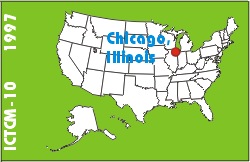
Electronic Proceedings of the Tenth Annual International Conference on Technology in Collegiate MathematicsChicago, Illinois, November 6-9, 1997Paper C046Let's Talk: Using Conferencing Software in Mathematics Courses |
Paul K. SwetsIndiana University Bloomington, IN 47405 USA Phone: (812) 855-1064 pswets@indiana.edu |
| Click to access this paper: |
ABSTRACT
Modern conferencing software can provide real benefits to the mathematics teacher in feedback, in collaborative work, in distance learning, and in fostering student communication.Conferencing software provides a ready avenue for classroom assessment and feedback, so the instructor can more closely monitor what is working and what is not. Feedback generated via conferencing software retains the immediacy and relevance of many of the quick assessment techniques, while not sacrificing classroom time. It also allows a more deliberative attitude on the part of students, which may result in more accurate evaluation.
Collaborative work is also enhanced through the use of conferencing software. Busy students can link for virtual, asynchronous ``meetings,'' allowing far more interaction than if face-to-face meetings are required. The instructor can also see the progressive refinement of ideas, where stumbling blocks occur, and who is making contributions to the group. In addition, conferencing software maintains a record, which may then be used for grading, for research, or for refinement and revision of projects.
Finally, there are many, well-known benefits which accrue when one can get students talking about mathematics. Conferencing software allows one more avenue for this communication. It is especially useful at larger schools, in larger classes, or anywhere a significant number of students do not know each other. Many of today's students are comfortable with online relationships, and communicate more freely via a terminal than in person.
Keyword(s): cooperative learning, distance learning
